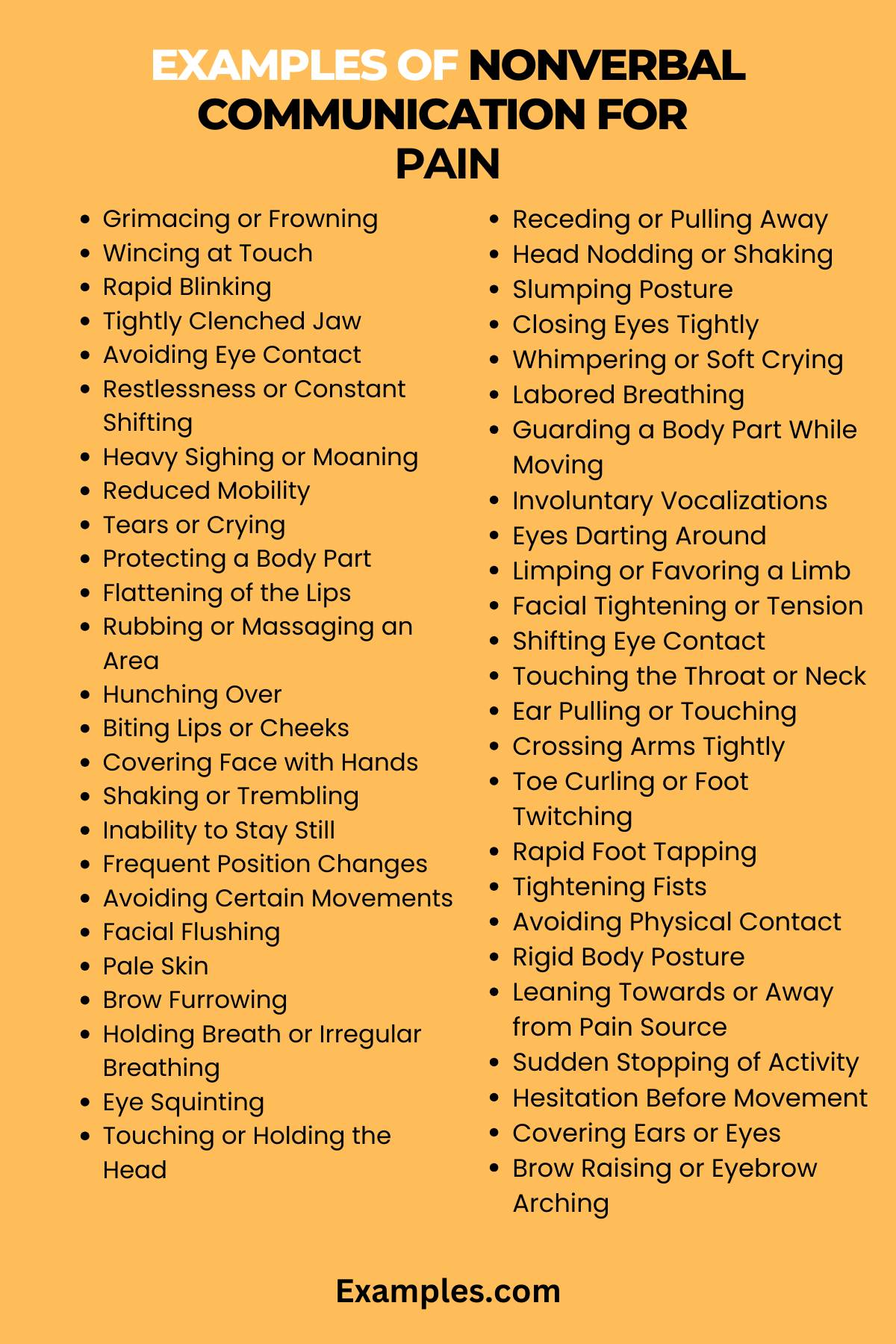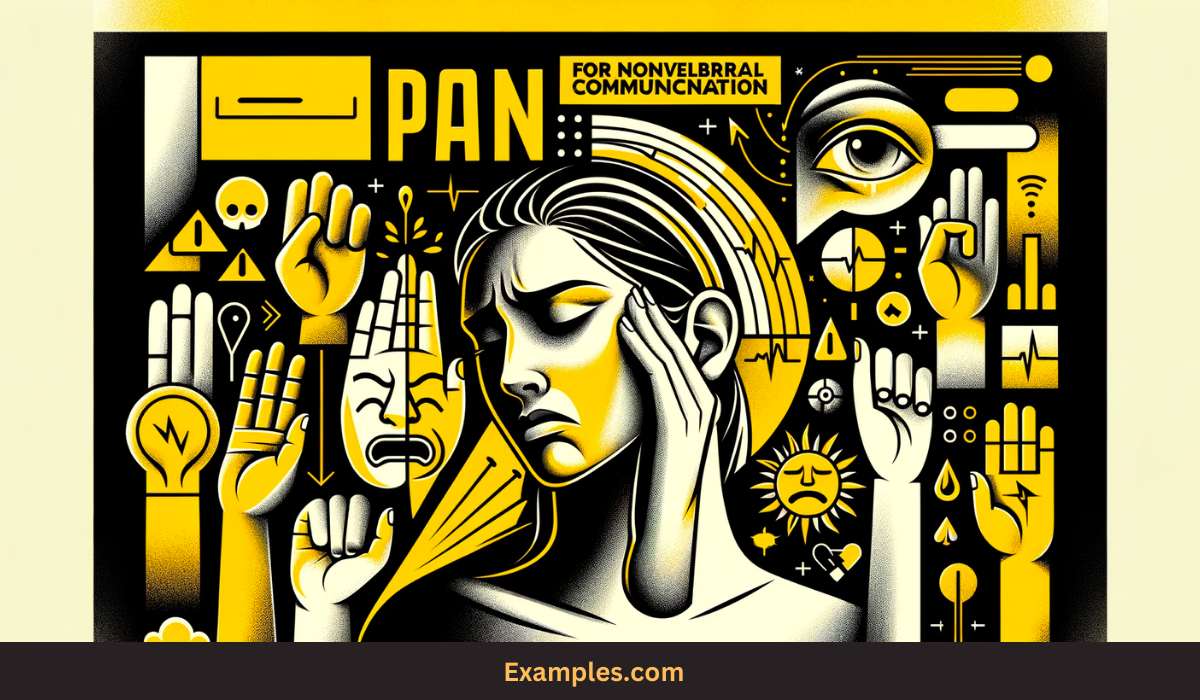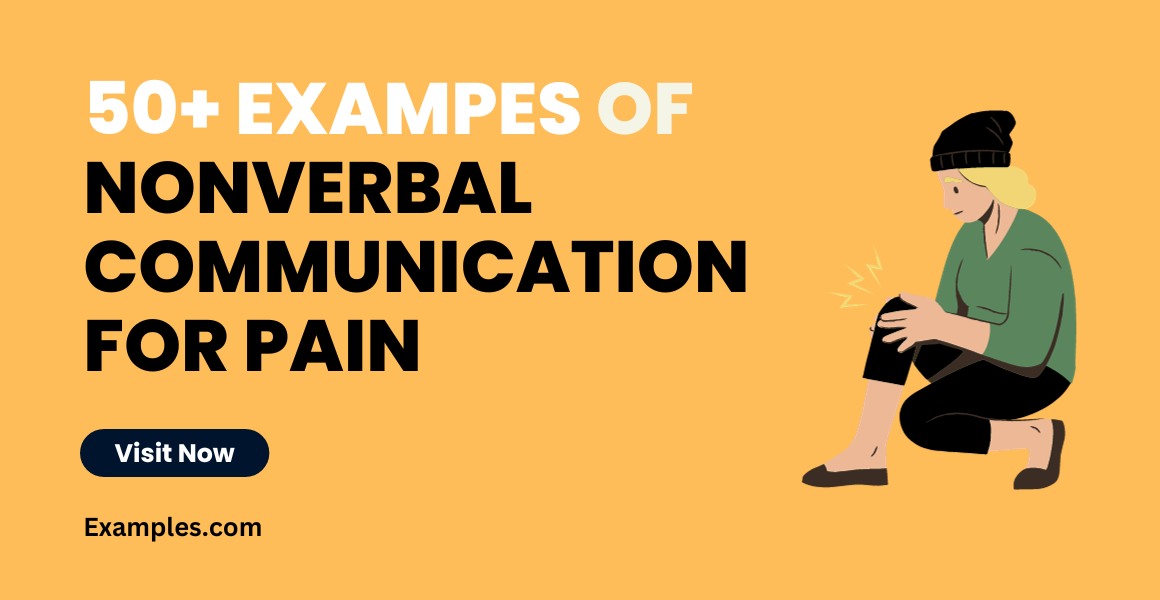49+ Nonverbal Communication for Pain Examples
Understanding pain through nonverbal cues is crucial in many professional and personal settings. Our comprehensive guide on Nonverbal Communication for Pain delves into this silent language, offering valuable insights and practical Nonverbal Communication Examples. We cover various aspects, from identifying subtle signs in different contexts to interpreting these cues effectively. This guide is an essential resource for anyone looking to enhance their understanding of nonverbal pain expressions, be it in healthcare, education, or everyday interactions.
What is Nonverbal Communication in Nursing? – Definition
Nonverbal communication in nursing refers to the ways in which nurses understand and respond to patients’ needs and emotions without spoken words. This includes observing body language, facial expressions, and gestures, crucial for assessing a patient’s comfort and pain levels. This form of communication is essential in healthcare settings, particularly when dealing with nonverbal patients or those with communication barriers. It’s a key aspect of Nonverbal Communication Skills and plays a significant role in Nonverbal Communication in Daily Life within a medical context.
What is the Best Example of Nonverbal Communication for Pain?
A prime example of nonverbal communication for pain is the observation of facial expressions. Signs such as grimacing, furrowed brows, or wincing can indicate discomfort or suffering. In nursing and healthcare, recognizing these expressions is vital for effective pain management. This understanding forms a part of Nonverbal Communication for Nurses and is an important aspect of Nonverbal Communication Skills. By interpreting these nonverbal cues, healthcare professionals can provide appropriate care and pain relief, even when verbal communication is not possible.
50 Examples of Nonverbal Communication for Pain
Nonverbal communication for pain involves silent cues indicating discomfort. It’s crucial in contexts where verbal expression is limited. This guide presents 50 Unique, Distinct & Best Examples of such communication, each explained with its significance in conveying pain. These examples are essential for understanding nonverbal cues in healthcare, education, and caregiving, enhancing Nonverbal Communication Skills and empathy.

- Grimacing or Frowning: Indicates severe discomfort or pain. Communicate by saying, “I see your discomfort. How can I help?”
- Wincing at Touch: Shows pain in a specific area. Respond with, “I noticed that touched area caused pain. Let’s be gentle there.”
- Rapid Blinking: Sign of distress or sharp pain. Acknowledge by asking, “Are you feeling a sudden pain right now?”
- Tightly Clenched Jaw: Reflects enduring or intense pain. Approach with care, asking, “Your expression seems to show you’re in a lot of pain. How can I assist?”
- Avoiding Eye Contact: Often a sign of enduring discomfort. Gently inquire, “I see you’re avoiding eye contact. Is there pain you’d like to discuss?”
- Restlessness or Constant Shifting: Indicates ongoing discomfort. Say, “Your restlessness seems to indicate pain. How can we make you more comfortable?”
- Heavy Sighing or Moaning: Reflects exhaustion from constant pain. Approach by asking, “I hear your sighs. Are you feeling overwhelmed by pain?”
- Reduced Mobility: Hesitation or difficulty moving can signal pain. Ask, “I notice you’re moving differently. Are you experiencing pain?”
- Tears or Crying: Direct indication of pain or discomfort. Respond with empathy, “I see your tears. Can you tell me where it hurts?”
- Protecting a Body Part: Guarding or favoring a body part suggests pain. Inquire, “You seem to be protecting your arm. Is it hurting?”
- Flattening of the Lips: A sign of trying to mask pain. Ask, “Your lips are pressed together. Are you trying to hide your pain?”
- Rubbing or Massaging an Area: Indicates pain or discomfort in that area. Say, “I see you’re massaging your shoulder. Is it in pain?”
- Hunching Over: Can signal abdominal pain or discomfort. Inquire with, “Your posture has changed. Are you feeling abdominal pain?”
- Biting Lips or Cheeks: Sign of managing pain or discomfort. Acknowledge by asking, “Are you biting your lip due to pain?”
- Covering Face with Hands: Often a sign of overwhelming pain. Communicate concern, “I see you’re covering your face. Is the pain too much?”
- Shaking or Trembling: Can indicate extreme pain or discomfort. Gently ask, “You’re shaking. Is it because of pain?”
- Inability to Stay Still: Restlessness can be a response to pain. Inquire, “You seem unable to stay still. Are you in pain?”
- Frequent Position Changes: Trying to find a comfortable position due to pain. Say, “You’re changing positions often. Is it to ease pain?”
- Avoiding Certain Movements: Indicates pain during specific movements. Ask, “Are you avoiding bending because it causes pain?”
- Facial Flushing: Can be a reaction to intense pain. Check with, “Your face is flushed. Is this a sign of pain?”
- Pale Skin: Sometimes a sign of shock or severe pain. Inquire, “Your skin looks pale. Is this due to pain?”
- Brow Furrowing: Indicative of concentration on pain or discomfort. Ask, “Your brows are furrowed. Are you focusing on a painful area?”
- Holding Breath or Irregular Breathing: Indicates managing or bracing for pain. Say, “Your breathing changed. Is it because of pain?”
- Eye Squinting: Often a reaction to sharp or sudden pain. Check with, “You’re squinting your eyes. Is that due to pain?”
- Touching or Holding the Head: Suggests headache or head pain. Inquire, “You’re holding your head. Are you experiencing a headache?”
- Receding or Pulling Away: Indicates pain on contact or approach. Say, “You pulled away. Is that area painful?”
- Head Nodding or Shaking: Nonverbal indication of pain level or location. Ask, “Your head nodding. Does that mean the pain is here?”
- Slumping Posture: Can signal general discomfort or fatigue from pain. Inquire, “Your posture has slumped. Is it due to pain?”
- Closing Eyes Tightly: A common reaction to intense or sharp pain. Acknowledge with, “You’ve closed your eyes tightly. Is the pain severe?”
- Whimpering or Soft Crying: Reflects mild to moderate pain. Respond by asking, “You’re whimpering. Is it because of the pain?”
- Labored Breathing: Indicates stress or pain affecting breathing. Ask, “Your breathing is labored. Is pain causing this?”
- Guarding a Body Part While Moving: Protective behavior suggests pain in that area. Inquire, “You’re guarding your leg. Is it in pain when you move?”
- Involuntary Vocalizations: Such as groans, can indicate pain. Respond with, “I heard a groan. Are you feeling pain right now?”
- Eyes Darting Around: Can suggest searching for relief or escape from pain. Say, “Your eyes are moving rapidly. Are you in distress?”
- Limping or Favoring a Limb: Indicates pain in a specific limb. Check with, “You’re limping. Is your leg hurting?”
- Facial Tightening or Tension: Reflects an effort to control or endure pain. Ask, “Your face seems tense. Is it due to pain?”
- Shifting Eye Contact: Might indicate discomfort in discussing or acknowledging pain. Inquire, “You’re shifting your gaze. Is it hard to talk about the pain?”
- Touching the Throat or Neck: Suggests throat pain or difficulty swallowing. Say, “You’re touching your throat. Is there pain there?”
- Ear Pulling or Touching: Indicates ear pain or discomfort. Ask, “You’re pulling your ear. Are you experiencing ear pain?”
- Crossing Arms Tightly: Can be a self-soothing gesture during pain. Inquire, “Your arms are crossed tightly. Is this a reaction to pain?”
- Toe Curling or Foot Twitching: Suggests pain in the lower extremities. Check with, “Your toes are curling. Is that a sign of foot pain?”
- Rapid Foot Tapping: Might be a response to pain or anxiety. Say, “You’re tapping your foot quickly. Is it because of pain?”
- Tightening Fists: Often a sign of trying to manage or bear pain. Ask, “Your fists are clenched. Are you coping with pain?”
- Avoiding Physical Contact: Suggests sensitivity or pain upon touch. Inquire, “You’re avoiding contact. Is it because of pain in that area?”
- Rigid Body Posture: Can indicate bracing against pain. Say, “Your body is rigid. Is this a reaction to pain?”
- Leaning Towards or Away from Pain Source: Indicates location and intensity of pain. Check with, “You’re leaning away. Is the pain on that side?”
- Sudden Stopping of Activity: A sign of pain interrupting normal actions. Ask, “You stopped suddenly. Did pain cause that?”
- Hesitation Before Movement: Indicates anticipation of pain with movement. Inquire, “You hesitated. Are you expecting pain with that movement?”
- Covering Ears or Eyes: Suggests overwhelming pain or sensory overload. Say, “You’re covering your ears. Is the pain too intense?”
- Brow Raising or Eyebrow Arching: Can signal surprise or sudden pain. Check with, “Your eyebrows went up. Is that a reaction to pain?”
What Are Some Non-Verbal Communication Signs of Pain?
Non-verbal communication signs of pain are crucial indicators, especially in healthcare and caregiving settings. These signs encompass a range of physical and behavioral cues that express discomfort without the use of words. Key signs include:
- Facial Expressions: Grimacing, frowning, and clenching the jaw can indicate pain.
- Body Language: Guarding a body part, limping, or a hunched posture often signifies discomfort.
- Vocalizations: Moaning, sighing, or groaning can be involuntary responses to pain.
- Eye Movements: Rapid blinking or avoiding eye contact might signal distress.
- Behavioral Changes: Restlessness, reduced mobility, or changes in sleep patterns can be signs of pain.
Understanding these signs is essential in Nonverbal Communication for Nurses, Nonverbal Communication for Autism, and Nonverbal Communication in Different Cultures. Recognizing and correctly interpreting these cues can greatly aid in pain management and patient care.
Differences in the Nonverbal Communication of Pain
The nonverbal communication of pain can vary based on several factors. Here’s a table outlining key differences:

| Factor | Typical Nonverbal Cues | Description |
|---|---|---|
| Age | Younger individuals might cry or scream, while older individuals may show more subtle signs like grimacing. | Different age groups express pain differently, with younger individuals often being more vocal and expressive. |
| Cultural Background | Varied expressions based on cultural norms, such as stoicism in some cultures versus more expressive behaviors in others. | Cultural norms significantly influence how individuals express pain nonverbally. |
| Type of Pain | Acute pain often results in more evident signs like sharp intakes of breath, whereas chronic pain may be expressed through fatigue or irritability. | The nature of pain (acute vs chronic) affects its nonverbal expression. |
| Personal Characteristics | Individual pain tolerance and personality can lead to varied expressions, ranging from overt to subtle. | Personal pain thresholds and personality traits play a role in how pain is nonverbally communicated. |
| Contextual Factors | In a healthcare setting, patients might express pain differently compared to at home due to perceived social expectations. | The environment and context can influence how individuals nonverbally communicate pain. |
This table highlights the complexity of Nonverbal Communication for Pain. Understanding these differences is vital for professionals working in diverse settings, enhancing their ability to provide appropriate care.
- Facial Expressions: One of the most immediate indicators of pain is facial expression. Grimacing, furrowing brows, and tightly closing eyes are common signs.
- Body Movements and Posture: Body language such as guarding a painful area, limping, or adopting a fetal position can signal discomfort or pain.
- Vocal Sounds: Although not verbal language, sounds like moaning, groaning, or gasping can indicate the presence and intensity of pain.
- Physiological Responses: Sweating, changes in skin color, increased heart rate, and altered breathing patterns are physiological responses that can accompany pain.
- Behavioral Changes: Alterations in normal behavior, such as restlessness, aggression, or withdrawal, can also be indicators of pain.
Understanding these types is essential for Nonverbal Communication in Nursing and other caregiving fields, allowing for better patient care and pain management.
Types of Nonverbal Communication for Pain
In the realm of Nonverbal Communication for Pain, there are several distinct types that healthcare professionals, educators, and caregivers need to recognize. These types are crucial for understanding and responding to individuals who cannot communicate their pain verbally.
- Facial Expressions: One of the most immediate indicators of pain is facial expression. Grimacing, furrowing brows, and tightly closing eyes are common signs.
- Body Movements and Posture: Body language such as guarding a painful area, limping, or adopting a fetal position can signal discomfort or pain.
- Vocal Sounds: Although not verbal language, sounds like moaning, groaning, or gasping can indicate the presence and intensity of pain.
- Physiological Responses: Sweating, changes in skin color, increased heart rate, and altered breathing patterns are physiological responses that can accompany pain.
- Behavioral Changes: Alterations in normal behavior, such as restlessness, aggression, or withdrawal, can also be indicators of pain.
Understanding these types is essential for Nonverbal Communication in Nursing and other caregiving fields, allowing for better patient care and pain management.
Pain Chart for Nonverbal Communication
A pain chart for nonverbal communication is a visual tool used to assess and understand pain levels in individuals who cannot communicate verbally. This chart typically includes:

- Facial Expression Scale: Images showing different levels of pain through facial expressions.
- Body Language Indicators: Diagrams indicating common pain-related postures or movements.
- Color Coding: Colors representing different pain intensities, making it easier to assess at a glance.
Such charts are instrumental in Nonverbal Communication for Autism, where verbal communication might be limited, and in diverse cultural contexts.
How to Assess Pain in Nonverbal Communication
Assessing pain in nonverbal individuals is a critical skill in healthcare and caregiving. Here’s a guide to effectively evaluate pain through nonverbal cues:
- Observation: Carefully observe the individual’s facial expressions, body movements, and posture for signs of discomfort or pain.
- Listening: Pay attention to any vocal sounds like moans or sighs that could indicate pain, even in the absence of verbal communication.
- Physiological Monitoring: Check for physiological signs such as changes in heart rate, breathing patterns, or sweating.
- Behavioral Analysis: Note any changes in the person’s usual behavior, including sleep patterns, appetite, or social interactions.
- Consistency Check: Regularly assess these signs over time for consistency, as pain can fluctuate in intensity and expression.
- Use of Assessment Tools: Implement pain assessment tools designed for nonverbal communication, like pain scales with facial expressions or body language charts.
- Seeking Feedback: If possible, seek feedback from others who know the individual well, such as family members or caregivers, to better understand their typical pain expressions.
Effectively assessing pain in nonverbal communication is vital in various settings, from Nonverbal Communication for Autism to elder care, ensuring appropriate and compassionate care is provided.
In conclusion, understanding nonverbal communication for pain is crucial in providing empathetic and effective care. This guide, enriched with examples and practical tips, offers invaluable insights into recognizing and responding to pain without the need for words. It’s an essential resource for healthcare professionals, educators, and caregivers, enhancing their ability to connect and provide comfort in situations where verbal communication is limited.



